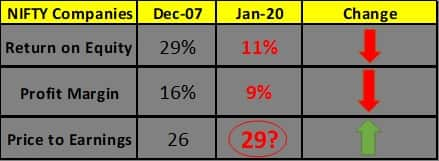I believe the stock market may crash only when the US Fed stops printing money. If the Fed keeps printing money then every correction in the market may be short lived.
"Global Markets have already bounced back from March lows, hence we advise to follow systematic process of investment rather than lump sum amount now, we may have better entry points within five to six months," Amit Jain, Co-founder & CEO at Ashika Wealth Advisors said in an interview with Moneycontrol's Sunil Shankar Matkar.
Q: How should one build up his/her post COVID-19 portfolio, what are things to look at? What should one include/avoid while building up a post COVID portfolio?
As we all feel, COVID-19 has decimated global economy & business models by restricting our mobility. Due to this restricted mobility, all businesses of the economy have suffered & this time it is unlike the 2008 crisis, which was only restricted to the financial sector. In the history of the world, this is the first time ever when oil has traded in the negative price range, due to restriction on free movement of goods & services. In such global economic scenario, for building a pandemic proof portfolio, investors should follow below four principals with disciplined approach:
ii) Invest in "asset light models" rather than "asset heavy models";
iii) Investors should follow our philosophy of "Invest Rightly, Switch Timely" across product categories;
iv) Periodic rebalancing across asset classes like gold, equities (domestic & international) & fixed income.
For equities we advise to invest in quality multicap funds which have exposure to domestic consumption themes at a reasonable valuation. We are bullish on below sectors from medium term prospective:
A) IT sector companies who are increasing their revenues from artificial intelligence & automation processes
B) Personal mobility space particularly two wheeler & affordable four wheeler
C) Healthcare
D) Telecom.
Global Markets have already bounced back from March lows, hence we advise to follow a systematic process of investment rather than lump sum amount now, we may have better entry points within five to six months.
Q: What could be the next key triggers (positive/negative - global/domestic) for the market, especially after the government started re-opening economy in phases?
Now the global economy is opening partially which may be a good sign on the economic front, but this comes with a risk of community spread of COVID-19 which at later stage may have severe impact on human lives.
If this infection increases at an exponential rate, then we may see lockdown Part-2 in some parts of the world including India. If it happens then it may have much severe repercussions on global growth.
Also, we see new geo-political world power as apparently western countries are talking about economic distancing from China, which may trigger some intense trade war or currency war.
Today US Dollar dominates 90 percent of global trade as it is the reserve currency of the world. However, the US Economy has a threat of total unfunded liability of $148 trillion which is almost seven times their annual GDP.
Any significant & sudden rift with China, may trigger sell off in US treasury bonds. As on date, China is the leading investors in US government bonds with 17 percent allocation. To me, this looks like a much bigger risk in the medium term for global economy & stock markets.
Also depressed Q1 earnings along with uncertainty on the US election in November 2020 shall keep any upmove in the market under check.
Q: Some analysts start saying that the market may be starting discounting FY22 earnings expectations to some extent and that is one of the reasons for current rally in the market? Do you feel so and do you really expect strong earnings growth from FY22 onwards given everyone is saying FY21 could post weak earnings and economic growth?
I don’t agree with that statement. In my view, the current market rally is liquidity driven, which lacks fundamental strength. If I put it straight then I believe that post 2008 entire global stock market rally was liquidity driven.
Fed has doubled the currency circulation in the last 12 years which is getting its due allocation to global stock markets. To build further, the Fed has printed almost $3 trillion (Rs 220 lakh crore) in the last four months which has lifted the global stock market. Even if 1 percent of this gets allocated in Indian stock market then our Sensex can double, as our overall market cap was $2 trillion till December 2019.
Post 2008, I have hardly seen any linear connection in return on equity, profit margins & stock market valuation. The table may help you to understand the dichotomy of corporate performance & stock market valuations.

Hence, I believe the stock market may crash only when the US Fed stops printing money. If the Fed keeps printing money then every correction in the market may be short-lived.
Q: Entire banking space has been the leader in the current rally. Do you think this is the hope rally or the sector rally is ignoring risks that are likely to increase (in terms of NPA etc) going forward?
Yes you are right, the banking sector had been the leader in Nifty50 from April 2009 to January 2020. However, we were cautious on the banking sector even before COVID-19 crisis. We had already advised all our investors to exit banking stocks on January 16, 2020. Now post COVID-19 we are even more cautious on this sector.
If we go back to the basics of economics, in any economy, the banking sector does well when we have an expansionary phase of the economy. India had been in this expansionary phase for the last seventeen years (since 2003). However, this year Indian economy may be contracting & may register negative GDP growth first time ever post-Independence.
This contracting balance sheet of Indian economy, along with the worsening situation of old economy business models like power, infra, telecom, real estate, we believe this sector will face further headwinds.
To add to their woes, declining rate of interest cycle may put further pressure on their treasury profits. In the end, declining economic activity may increase risk of NPAs as there is a crisis of confidence in lending to MSMEs & other sectors who need capital.
Hence, we believe this hope rally may fizzle out soon. Investors need to be cautious on these sectors & even if they have a compelling urge to invest in this sector then they should only go with leaders in this sector.
Q: Despite rally in the broader markets, the majority of midcaps and smallcaps are still 50 percent off their highs seen in 2017-18. Is it the time to pick these midcaps and smallcaps given the current environment?
I agree if you analyse top 1,500 midcap & smallcap companies, then you will observe that almost all are trading below their 2018 valuation & I feel it is rightfully so. We had advised our investors to exit from midcaps on February 4, 2018 as that index was trading at P/E of over 100 in December 2017.
In history we had never seen this kind of valuation for midcaps, hence we figured out it was a liquidity driven rally post demonetisation. Even in December 2007 when Sensex was at peak of its bull run, the midcap index was trading at P/E of 23, hence exit was the best option.
We always advise our investors to exit when there is exuberance in the stock market & enter when there is despair. Today midcap P/E is close to 19, hence investors with a high risk appetite can build a quality midcap portfolio in a staggered manner in next six months. One time investment now is not suggested. They should prefer midcaps in sunrise sectors with visible growth prospects.
Q: If someone aged 35 wants to create a portfolio with value of Rs 5 lakh and another person with age of 30 wants to create a portfolio with value of Rs 1 lakh, what is your advise to both and what should be their pecking order in the portfolio etc?
Before advising on any financial market product, risk profiling needs to be done in order to understand the risk appetite & time horizon as both investors are in their 30s. Their risk profiling includes various questions such as income per year, dependents in the family, ultimate goal behind investments etc.
A. For a conservative investor, the asset allocation will look something like this,
5 percent gold (natural hedge against equity);15 percent in equity, to gain advantage of emerging themes and attractive valuations;
20 percent in arbitrage Funds to provide for short term needs & hedge against the equity markets in volatile scenario;
25 percent ESS Fund (33 percent in Equity, 33 percent in Debt, 33 percent in Arbitrage);
35 percent in AAA-rated bonds or sovereign bonds or PSU bonds (average yield to maturity 7-8 percent).
B. For an aggressive investor, the asset allocation will look something like this,
5 percent gold (natural hedge against equity);10 percent in arbitrage Funds to provide for short term needs & hedge against the equity markets in volatile scenario;
15 percent bonds (to provide a regular income);
70 percent in equity to gain advantage of emerging themes and attractive valuations in the current market.
Disclaimer: The views and investment tips expressed by investment expert on Moneycontrol.com are his own and not that of the website or its management. Moneycontrol.com advises users to check with certified experts before taking any investment decisions.















